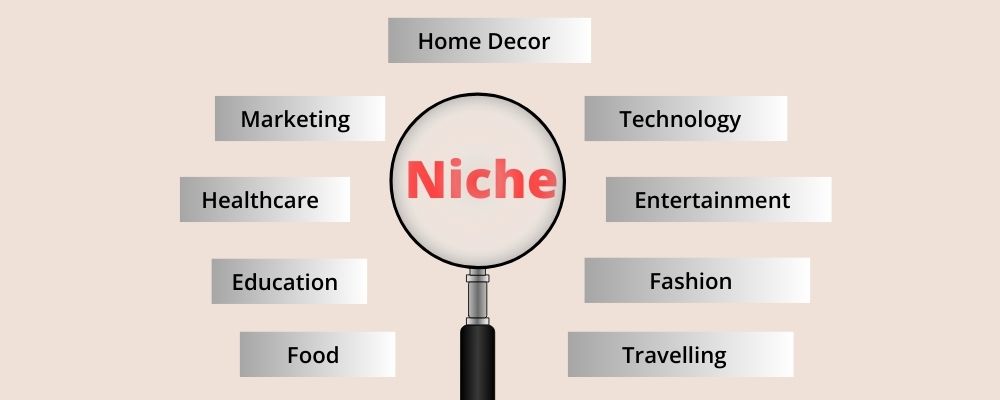Have you ever wondered how bloggers turn their passion into a full-time income? Whether you’re looking for a side hustle or dreaming of financial freedom, blogging can be a powerful way to make money online. But let’s be real—earning through blogging isn’t an overnight success story. It requires strategy, consistency, and the right monetization techniques.

How Can I Make Money from Blogging? A Step-by-Step Guide for Beginners
If you’re asking, “How can I make money from blogging?”, you’re in the right place. This guide will walk you through the practical steps to start a blog, grow an audience, and generate income effectively.
1. Choose a Profitable Niche
Picking the right niche is the first step towards a successful blog. Your niche should be:

- Profitable: Research if there are advertisers, affiliate programs, or products within your niche. Look for existing blogs in your chosen topic and analyze how they monetize. Are they selling digital products, running ads, or using affiliate marketing? This will give you an idea of what’s working.
- Passion-driven: Choose something you enjoy and can write about for years. Blogging requires consistency, and picking a niche you love will make it easier to stay motivated over the long run.
- Specific & Targeted: Niching down helps you attract a loyal audience. Instead of choosing a broad topic like “health and wellness,” focus on a sub-niche such as “holistic wellness for busy professionals.” A well-defined niche will help you stand out in the competitive blogging world.
- Evergreen & Trending Topics: Ensure your niche has a balance between evergreen content (timeless topics that remain relevant) and trending topics that attract bursts of traffic. For instance, a blog about “sustainable fashion” will always have an audience, while covering “seasonal fashion trends” can bring in periodic spikes in readership.
2. Set Up Your Blog
Setting up a blog involves several key steps to ensure a smooth start:

- Domain & Hosting: Your domain name is your blog’s identity, so pick one that is short, easy to remember, and relevant to your niche. Hosting is equally important—choose a reliable provider like Bluehost, SiteGround, or Kinsta that offers good speed, uptime, and support.
- Choose a Blogging Platform: WordPress.org is the most popular option due to its flexibility, customization options, and scalability. Other alternatives include Wix, Squarespace, and Blogger, but they may have limitations when it comes to monetization and advanced features.
- Install Essential Plugins: If using WordPress, install plugins like:
- Yoast SEO or Rank Math (for optimizing your blog for search engines)
- WP Rocket (for speed optimization)
- Elementor or Gutenberg (for easy content creation)
- Akismet (to prevent spam comments)
- Design & User Experience: First impressions matter! Choose a clean, mobile-friendly theme with fast loading speed. Many free and premium themes are available, such as Astra, GeneratePress, and Kadence. Ensure your site is easy to navigate, with clear categories and a search function.
- Create Essential Pages: Before you publish your first blog post, set up key pages like:
- About Page: Introduces who you are and what your blog is about.
- Contact Page: Helps brands and readers get in touch with you.
- Privacy Policy & Disclaimer: Essential for legal compliance, especially if you use ads or affiliate links.
3. Create High-Quality Content
Content is the foundation of any profitable blog. To attract and retain readers, your posts should be:
- Informative & Valuable: Solve a problem or answer a question your audience has. Conduct keyword research using tools like Google Keyword Planner or Ubersuggest to find relevant topics that people are actively searching for.
- SEO-Optimized: Use relevant keywords naturally in your content, optimize meta descriptions, add alt text to images, and use proper heading structures (H1, H2, H3) to improve search rankings.
- Engaging & Readable: Write in a conversational tone, break up long paragraphs, and use bullet points, images, and infographics to enhance readability.
- Consistent & Evergreen: Publish content consistently and include evergreen articles that remain relevant over time. Create a content calendar to maintain a steady publishing schedule.
- Call-to-Actions (CTAs): Encourage readers to take action, whether it’s subscribing to your newsletter, leaving a comment, or sharing your post on social media.
- Content Variety: Experiment with different content formats such as listicles, how-to guides, case studies, personal stories, and expert interviews to keep your audience engaged.
4. Monetization Strategies
Once your blog is up and running, here’s how you can start making money:
- Display Advertising

Join ad networks like Google AdSense, Mediavine, or Ezoic to display ads on your blog. Income is generated based on impressions (CPM) or clicks (CPC). The more traffic your blog gets, the higher your ad revenue.
- Best for: Blogs with high traffic
- Downside: Ads can sometimes disrupt the user experience if not placed strategically
- Pro Tip: Optimize ad placements by testing different positions to balance revenue and user experience.
2. Affiliate Marketing
Promote products or services and earn a commission for every sale made through your referral link. Some of the best affiliate programs include:
- Amazon Associates (physical products)
- ShareASale & CJ Affiliate (variety of brands)
- Digital affiliate programs like ConvertKit, Bluehost, and SEMrush
- Best for: Niche blogs with an engaged audience
- Pro Tip: Write in-depth product reviews, comparison posts, or tutorial-based content incorporating affiliate links.
3. Sponsored Content
Brands pay bloggers to create content featuring their products. The more traffic and engagement your blog has, the better sponsorship deals you can secure.
- Best for: Bloggers with an established audience & social media presence
- Types of Sponsored Content:
- Sponsored blog posts
- Product reviews
- Social media promotions
- Pro Tip: Reach out to brands directly with a media kit showcasing your blog’s traffic and engagement metrics.
4. Selling Digital Products
Selling digital products offers high profit margins since there are no production or shipping costs. Popular options include:

- E-books: Write guides related to your niche.
- Online Courses: Teach a skill via platforms like Teachable or Podia.
- Printables & Templates: Sell downloadable planners, worksheets, or design templates.
- Best for: Bloggers with expertise in a specific field
- Pro Tip: Use an email list to promote your digital products effectively.
5. Offer Coaching or Freelance Services
Use your blog as a portfolio to showcase expertise and attract clients for coaching, consulting, or freelance work.
- Examples of Services:
- Writing and content creation
- Social media management
- SEO consulting
- Business or life coaching
- Best for: Experts who want to monetize their skills
Pro Tip: Create a “Hire Me” page with testimonials and portfolio samples to attract potential clients.
5. Build & Grow Your Audience
A blog without an audience won’t make money. Here’s how to attract and retain visitors:

- SEO Optimization: Implement on-page SEO techniques such as keyword-rich content, proper meta tags, internal linking, and mobile-friendly design. Off-page SEO, like building backlinks from reputable websites, also boosts your search engine ranking.
- Email Marketing: Build an email list using lead magnets like free e-books, checklists, or exclusive content. Send regular newsletters with valuable insights, updates, and promotions to keep your audience engaged.
- Social Media Promotion: Share your blog posts on platforms like Instagram, Twitter, Facebook, LinkedIn, and Pinterest. Tailor your content for each platform and use hashtags, stories, and reels to maximize reach.
- Guest Blogging & Collaborations: Write guest posts for established blogs in your niche to attract new readers. Collaborate with influencers or fellow bloggers to expand your reach.
- Engage with Readers: Encourage comments, respond to queries, and create interactive content like polls and Q&A sessions. A strong community fosters trust and loyalty.
- Repurpose Content: Transform your blog posts into videos, podcasts, or infographics to reach audiences on different platforms and drive more traffic.
6. Track Performance & Optimizer
To ensure consistent growth, use analytics tools to track:
- Page views & visitor demographics: Understand who your audience is and where they come from.
- Most popular content: Identify high-performing posts and create similar content to increase traffic.
- Conversion rates for affiliate sales & digital products: Analyze what’s driving revenue and optimize those strategies.
- Bounce Rate & Time on Page: Measure engagement to see if visitors are staying on your site or leaving too soon. Lowering bounce rates can lead to higher revenue.
- Traffic Sources: Identify whether visitors are coming from organic search, social media, or referral sites, and focus on optimizing those channels.
- A/B Testing: Experiment with different headlines, call-to-actions, and ad placements to improve conversions.
Tools for Tracking & Optimization:
- Google Analytics: Provides detailed insights on traffic and user behavior.
- Google Search Console: Helps track search rankings and keyword performance.
- Rank Math or Yoast SEO: Improves SEO rankings and on-page optimization.
Heatmap Tools (Crazy Egg, Hotjar): Helps analyze user behavior and improve website layout for better engagement.
FAQs
Yes! Anyone can start a blog by choosing a niche, setting up a website, and creating valuable content. With consistency, you can grow and monetize it.
It varies, but most bloggers start earning within 6-12 months. Success depends on niche selection, traffic growth, and monetization strategies.
Popular methods include display ads (Google AdSense), affiliate marketing, sponsored content, selling digital products, and offering freelance services.
There’s no fixed number, but higher traffic increases earning potential. Some bloggers earn with 10,000 monthly visitors, while others need 50,000+ for significant income.
Yes, but investing in a domain, hosting, and marketing tools improves credibility and growth. Free platforms have limitations that can restrict monetization.
Focus on informative, SEO-friendly content like how-to guides, listicles, case studies, product reviews, and personal experiences to engage readers.
Conclusion
Blogging can be an incredible way to generate income, but success requires effort, patience, and continuous learning. The key to a profitable blog lies in choosing a niche that excites you, consistently delivering high-value content, and applying effective monetization strategies.
Remember, traffic alone won’t make you money—you need to optimize your blog for conversions, engage with your audience, and build trust over time. Stay adaptable to changes in the digital landscape, leverage multiple income streams, and always look for ways to improve your content and marketing efforts.
The journey to making money from blogging isn’t always smooth, but persistence pays off. Whether you aim for passive income, a side hustle, or a full-fledged career, applying these strategies will set you on the right path.
Are you ready to start your blogging journey? Apply these steps, stay consistent, and watch your blog grow into a money-making machine!


